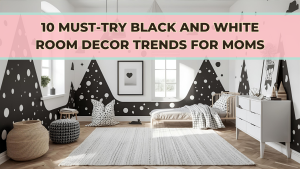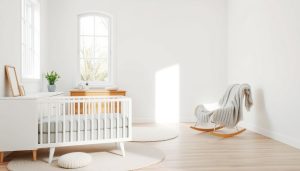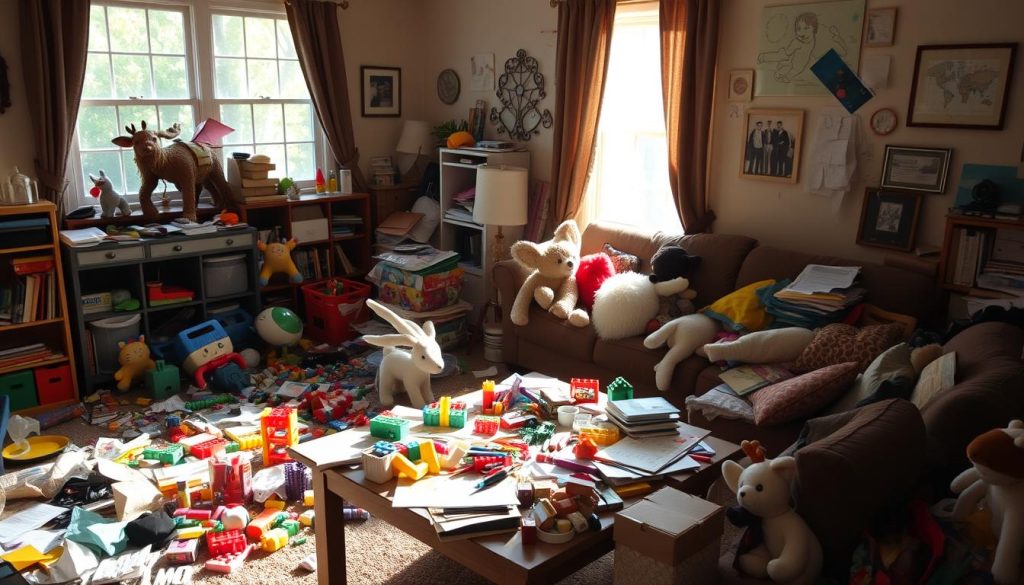
Being a busy parent means fighting a constant battle against clutter. It seems to fill every corner of our homes. With a curious toddler, keeping things organized can feel like a huge task. But, I’m here to say it’s not only possible but also vital for your family’s happiness.
We’ll look at ways to handle the mess, from toys to artwork. We’ll also find efficient storage solutions that fit your ideal clutter free home. Our aim is to help you create a tidy, peaceful home. This list of decluttering tips will support your child’s growth and creativity, while keeping your sanity intact.
Key Takeaways
- Decluttering with toddlers requires a patient, strategic approach
- Addressing your own clutter first sets the stage for success
- Implementing simple storage solutions and daily clean-up routines are game-changers
- Teaching children about organization through play fosters lifelong habits
- Creating clutter-free zones in your home preserves your sanity
Understanding the Challenge of Toddler Clutter
Raising a toddler means dealing with a lot of toys, art supplies, and other items. These things can quickly fill up our homes and make them feel chaotic. Traditional ways to organize might help a bit, but they often can’t keep up with how fast toddlers grow and explore.
Common Sources of Toddler-Related Mess
Toddlers love to explore and learn by touching and playing with everything. As soon as they start moving around, they collect lots of toys, books, and other things. These items spread out all over the house, making it hard to keep things tidy.
Impact on Family Living Space
Too much clutter from toddlers can really mess up our homes. It can make it hard to move around safely and feel relaxed. It also makes it tough to have fun times together, like playing or eating meals, because there’s just too much stuff.
Why Traditional Organization Methods Fail
Old ways of organizing don’t usually work for toddler mess. Toddlers grow fast, are always curious, and don’t really understand owning things. So, they might just take apart any system we try to set up, leading to endless mess and frustration.
To really tackle toddler clutter, we need a fresh, flexible plan. We should think about how their mess affects our homes and find new ways to handle it. This way, we can make our living spaces better for our toddlers and for our whole family.
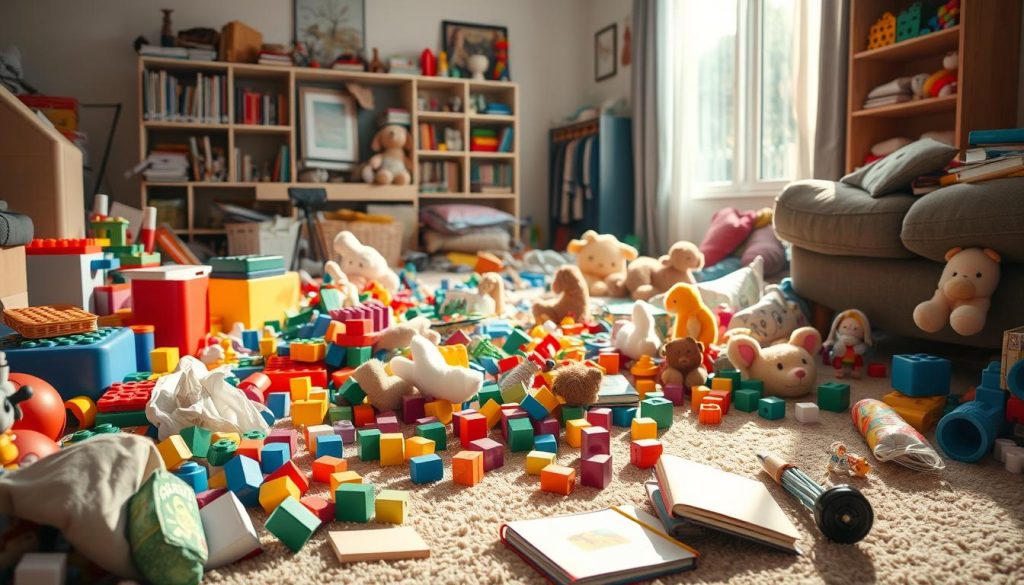
Starting with Your Own Clutter First
Declutter Your Life first. As parents, it’s easy to get caught up in the endless cycle of toddler-related clutter. But, it’s key to start with your own decluttering efforts first. This not only sets a good example for your child but also helps create a more organized home.
Many people struggle with decluttering certain areas, like sentimental items or books. By leading by example and decluttering your own spaces first, you build the skills needed for the tougher areas later.
Start by thinking about your shopping habits over the last month. Identify any items you’ve bought but never used. This self-awareness helps you develop a mindful decluttering mindset. It makes it easier to let go of things you don’t need.
Approach the adult organization process with a positive attitude. Focus on the benefits of living with less.
- Begin with a small area, like a drawer or a closet section. Feeling accomplished from a quick decluttering task motivates you to tackle bigger areas.
- Make clear rules for deciding what to keep, sell, donate, or throw away. This makes the process smoother and helps you avoid getting stuck on sentimental items.
- Be ready to face emotional challenges during decluttering. Have strategies to overcome them. The “penalty box” technique can help with items you’re unsure about.
By starting with your own personal decluttering, you create a more organized and peaceful home for your family. You also set a positive example for your toddler. You teach them about adult organization and the joys of living with less.
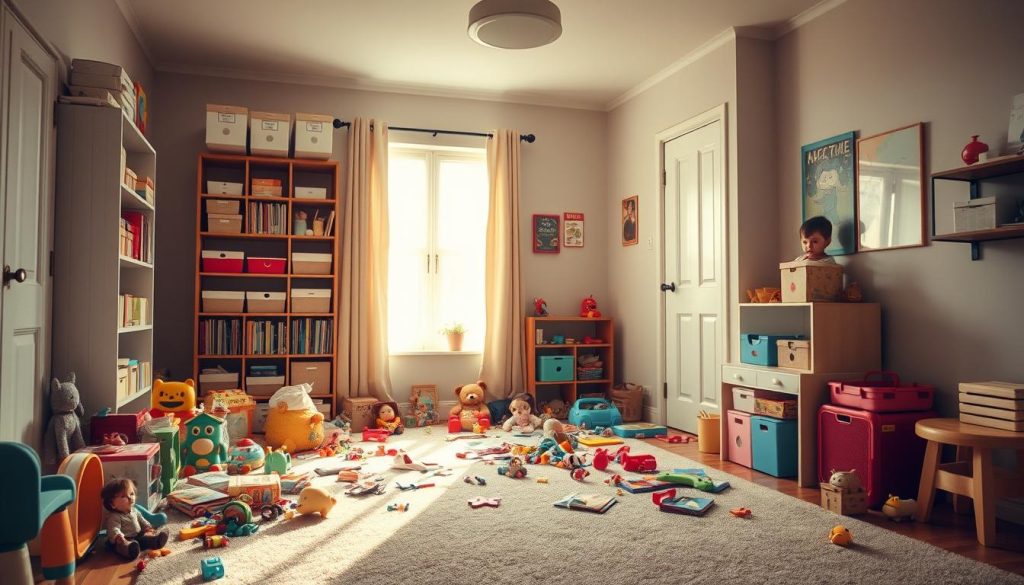
Essential Decluttering Tips for Parents
Managing the growing piles of toys, clothes, and other items with a toddler can be tough. But, with the right storage and clean-up routines, you can take back your space. This helps you meet your parenting goals.
Creating Simple Storage Solutions
Get labeled bins, baskets, and low shelves to organize your child’s stuff. It’s easy for them to put away their toys. Change out toys every week to keep things interesting and prevent clutter.
Establishing Daily Clean-up Routines
Do quick tidying sessions daily, like a 5-minute clean before bed. Give small rewards for keeping things organized. This motivates your child to help with clutter.
Setting Realistic Expectations
Remember, a spotless home is hard with young kids. The average American toddler has 139 toys, and a 10-year-old has about 248. Parenting experts say getting kids involved in cleaning teaches them important skills.
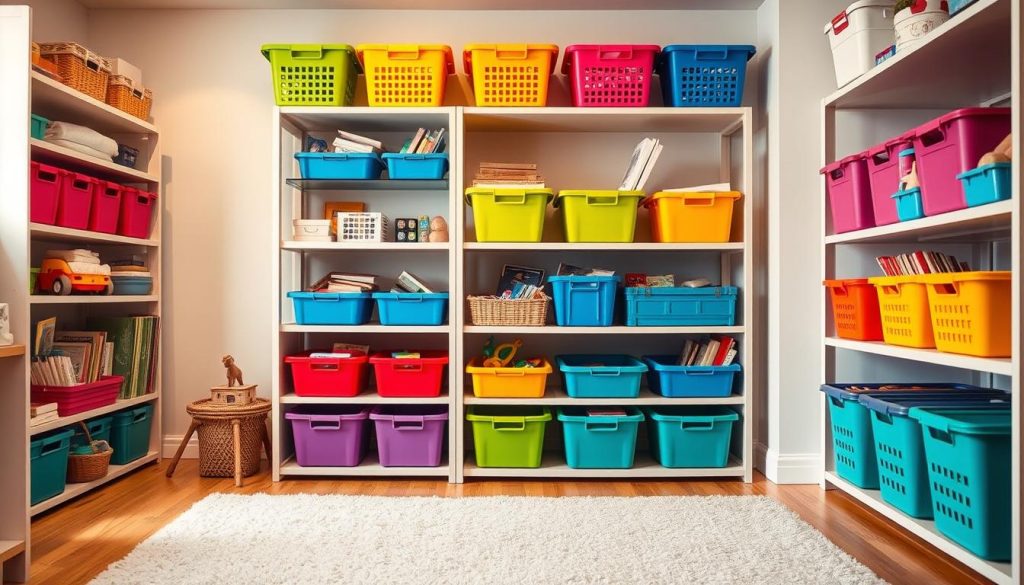
By following these decluttering tips, you can make your home a peaceful place. It balances your parenting expectations with the challenges of raising a toddler. A bit of structure and consistency helps keep your home tidy.
Teaching Toddlers About Organization Through Play
Using play to teach toddlers about organization is very effective. By adding organization activities to their play, you help them understand the value of a clean space. This way, they learn to manage their things better.
Begin with simple sorting games. These help your toddler put similar items together. Singing clean-up songs makes tidying up fun. Pretend play, like running a store or library, also teaches them to organize.
- Incorporate sorting games that teach your toddler to categorize toys, books, and art supplies by color, shape, or size.
- Introduce clean-up songs and chants that transform the mundane task of tidying up into a lively, interactive activity.
- Engage in imaginative play where your child assumes the role of a store owner, librarian, or caretaker, practicing organization skills in a playful context.
By making organization a part of play, you help your toddler develop important skills. You also teach them to keep their space clean. This sets them up for good habits as they get older.
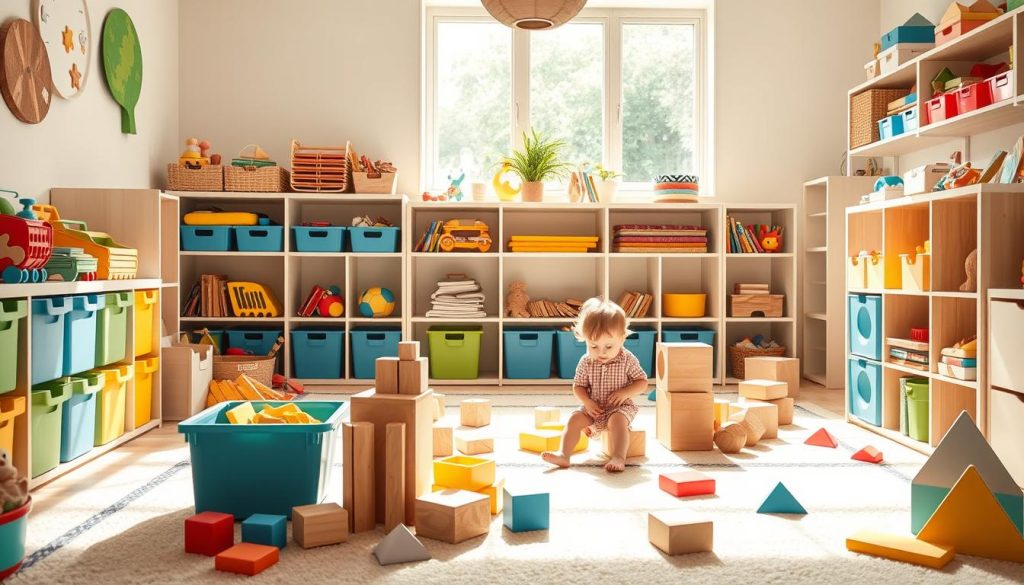
It’s important to make organization fun for your toddler. With creativity and patience, you can turn clutter into a chance for learning. This is all thanks to educational play.
Smart Storage Solutions for Toys and Games
Keeping a home tidy with kids can be tough. But, the right storage can help you stay organized. Try a rotating toy system or creative storage for small spaces. These decluttering tips will help manage clutter and involve your toddler in cleaning up.
Rotating Toy System Implementation
Managing too many toys is easier with a rotating system. Keep some toys hidden and switch them out every few weeks. This keeps your child interested and reduces clutter. Use bins or baskets with labels to store the hidden toys.
Creative Storage Ideas for Small Spaces
In small homes, using space wisely is key. Use wall shelves or hanging organizers to keep toys off the floor. Clear bins or baskets are great for small items. Also, think about repurposing furniture to hide toys when not in use.
Organizing Books and Art Supplies
Organizing books, art, and educational stuff is a big help. Set up special areas for these items with clear labels. Let your toddler help sort and arrange their things. This teaches them responsibility and makes it easier for them to find what they need.
| Storage Solution | Percentage of Tips Mentioning It |
|---|---|
| Over-the-door shoe organizers | 17 out of 25 (68%) |
| Freestanding bookcases or cubby systems | 19 out of 25 (76%) |
| Storage ottomans | 24 out of 25 (96%) |
| Acrylic display boxes mounted on walls | 14 out of 25 (56%) |
| Low, open shelves with bins and organizers | 11 out of 25 (44%) |
Using these smart storage ideas as decluttering tips for toy storage, small space organization, and book and art supply storage makes your home tidy and nice. It also encourages your toddler to help keep things organized.
Managing Sentimental Items and Artwork
As parents, we often find ourselves surrounded by sentimental clutter. This includes our children’s artwork, childhood keepsakes, and cherished family mementos. These items hold immense emotional value but can quickly take over our living spaces. By managing these items strategically, we can keep our homes organized and clutter-free.
Family heirlooms like jewelry, furniture, and old photographs are common sources of sentimental clutter. Personal keepsakes, such as childhood toys and wedding dresses, also contribute. Our children’s crafts and artwork add to the sentimental accumulation, making it hard to manage.
To tackle this challenge, setting boundaries and establishing a system is key. Start by identifying the most meaningful items that spark joy and evoke cherished memories. Consider digitizing photographs and documents to reduce physical clutter. Create memory boxes or designated spaces for the most precious keepsakes, limiting the number to maintain an organized living environment.
- Establish clear criteria for what to keep, such as a certain number of items or a specific amount of space allocated for sentimental storage.
- Use labeled boxes or containers to sort items into “Keep,” “Donate,” “Sell,” and “Trash/Recycle” categories.
- Set a timer for 20-30 minutes to make quicker decisions and avoid getting bogged down in emotional overwhelm.
- Utilize supplies like a hand vacuum and microfiber cloths to clean and maintain the organization of sentimental items.
- Take photographs of items being let go of to preserve the memory without the physical clutter.
Decluttering sentimental items and children’s artwork can be emotionally challenging. Acknowledging these challenges helps us approach the task with compassion and clarity. Recognizing the fear of forgetting memories and feelings of guilt can guide us. Defining “enough” by identifying the most significant items helps alleviate the burden of excessive sentimental clutter.
The journey of managing sentimental items and children’s artwork is about balance. It’s about preserving cherished memories while maintaining a clutter-free, harmonious living space. By adopting a thoughtful and strategic approach, we can honor the sentimental value of these items and create a more organized and peaceful home environment.
Creating Clutter-Free Zones in Your Home
As parents, we face the challenge of keeping our homes tidy with toddlers around. But, with some smart strategies, we can make clutter-free zones. These zones help us keep our sanity and make our homes peaceful.
Designating Play Areas
Creating specific designated play areas is key to managing toddler clutter. By limiting toys to certain spots, we keep the rest of the house clean. We can set up a cozy reading corner, an art station, or a play area with bins for easy clean-up.
Maintaining Clean Spaces
It’s also vital to have clutter-free zones in the home where toys are not allowed. This could be the kitchen, dining room, or living areas. By setting these rules, we create a calm space for everyone to relax.
Quick Clean-up Strategies
To keep our clutter-free zones clean, we can use quick clean-up strategies daily. A “five-minute tidy” each evening can make a big difference. It helps us stay organized and prepares us for the next day. Teaching our kids to help with these clean-ups teaches them important habits early on.
By setting up clutter-free zones, designated play areas, and quick clean-up strategies, we can make our homes peaceful. Even with the chaos of raising a toddler, we can keep our spaces tidy. With a bit of planning and consistency, we can enjoy a clutter-free home.
Building Positive Decluttering Habits as a Family
Creating a clutter-free home is a family effort. Involve everyone in decluttering to build a culture of organization. Set aside time for regular family decluttering sessions. This makes it a team effort, not just one person’s job.
Get your kids involved in decluttering. Give them rewards or special privileges for helping. This makes decluttering fun, not a chore. Try family challenges or games to make it fun for all.
- Have a weekly “Tidy Time” where everyone helps declutter and organize.
- Let your kids sort their things, deciding what to keep or give away.
- Celebrate small wins, like a tidy bookshelf or fewer toys.
Building good decluttering habits takes time and patience. Enjoy the journey, celebrate your wins, and focus on a cleaner, happier home.
“The family that declutters together, stays together.” – Organizational Guru, Jane Doe
Addressing Common Decluttering Challenges
Parenting is full of challenges, and decluttering your home is one of the toughest. Managing toys, handling hand-me-downs, and seasonal storage can feel overwhelming. But, with the right strategies, you can overcome these clutter challenges and take back your space.
Dealing with Toy Overflow
Toys can be a nightmare for parents. To control the toy chaos, adopt a “one in, one out” rule. When a new toy comes in, an old one must go. Regularly get rid of unused toys by donating or selling them. This rule can stop toys from taking over your home.
Managing Hand-me-downs
Hand-me-downs are great for saving money, but they can add to clutter. Go through hand-me-downs right away, keeping only what your child will use soon. Store the rest in labeled bins or boxes, switching them out as needed.
Seasonal Item Storage
Seasonal clothes, decorations, and items can clutter your home if not managed. Use clear storage containers and label them by category and season. Switch these items as the seasons change, keeping only what you need now. This method reduces clutter and makes it easy to find what you need.
By addressing toy overflow, hand-me-downs, and seasonal storage, you can conquer common clutter challenges. With some organization and a regular decluttering routine, your home can stay peaceful, even with a toddler.
| Decluttering Challenge | Effective Strategies |
|---|---|
| Toy Overflow |
|
| Managing Hand-me-downs |
|
| Seasonal Item Storage |
|
“The first step in crafting the life you want is to get rid of everything you don’t.”
– Joshua Becker
Conclusion
Decluttering your home with a toddler can seem hard. But, with the right strategies, you can make your space tidy again. This list of decluttering tips will not only reduces stress but also helps your family live more organized.
To succeed to having a clutter free home, start by building good habits and setting achievable goals. Involve your toddler in cleaning up. This way, you can teach them about keeping things organized while making your home peaceful.
Creating a tidy home is an ongoing effort, not a one-time task. Stick to the decluttering success, organized family life, and parenting tips we’ve shared. Keep your home clutter-free to enjoy parenting more fully.

